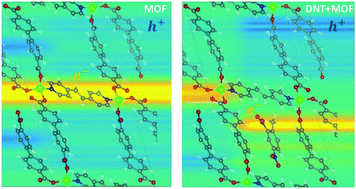Quenching of photoluminescence in a Zn-MOF sensor by nitroaromatic molecules†
Abstract
We uncover the exact mechanisms that lead to a quenching of the photoluminescence in a Zn-based metal organic framework (MOF) material upon nitroaromatic molecule adsorption. We present evidence based on ab initio simulations, coupled with in situ IR spectroscopy and photoluminescence measurements, showing that quenching occurs as the result of a shift of the lowest unoccupied orbital from the MOF host to the guest molecule. Our results provide a mechanistic understanding of quenching of photoluminescence in MOFs and are of importance for chemical sensing applications, where they aid the design of novel MOFs with increased sensing selectivity.



 Please wait while we load your content...
Please wait while we load your content...